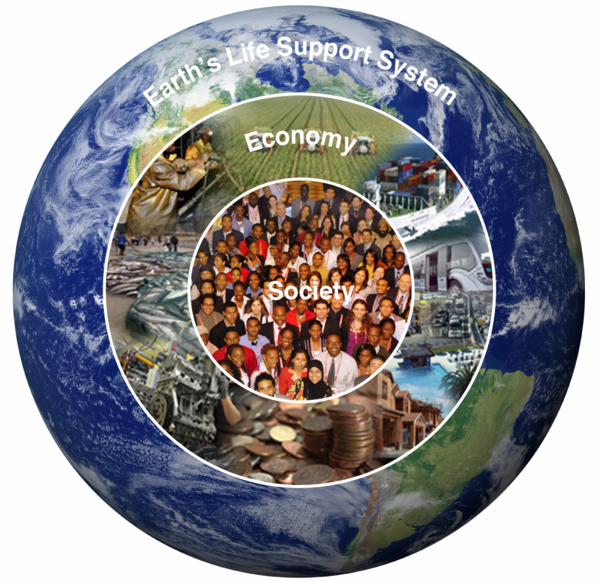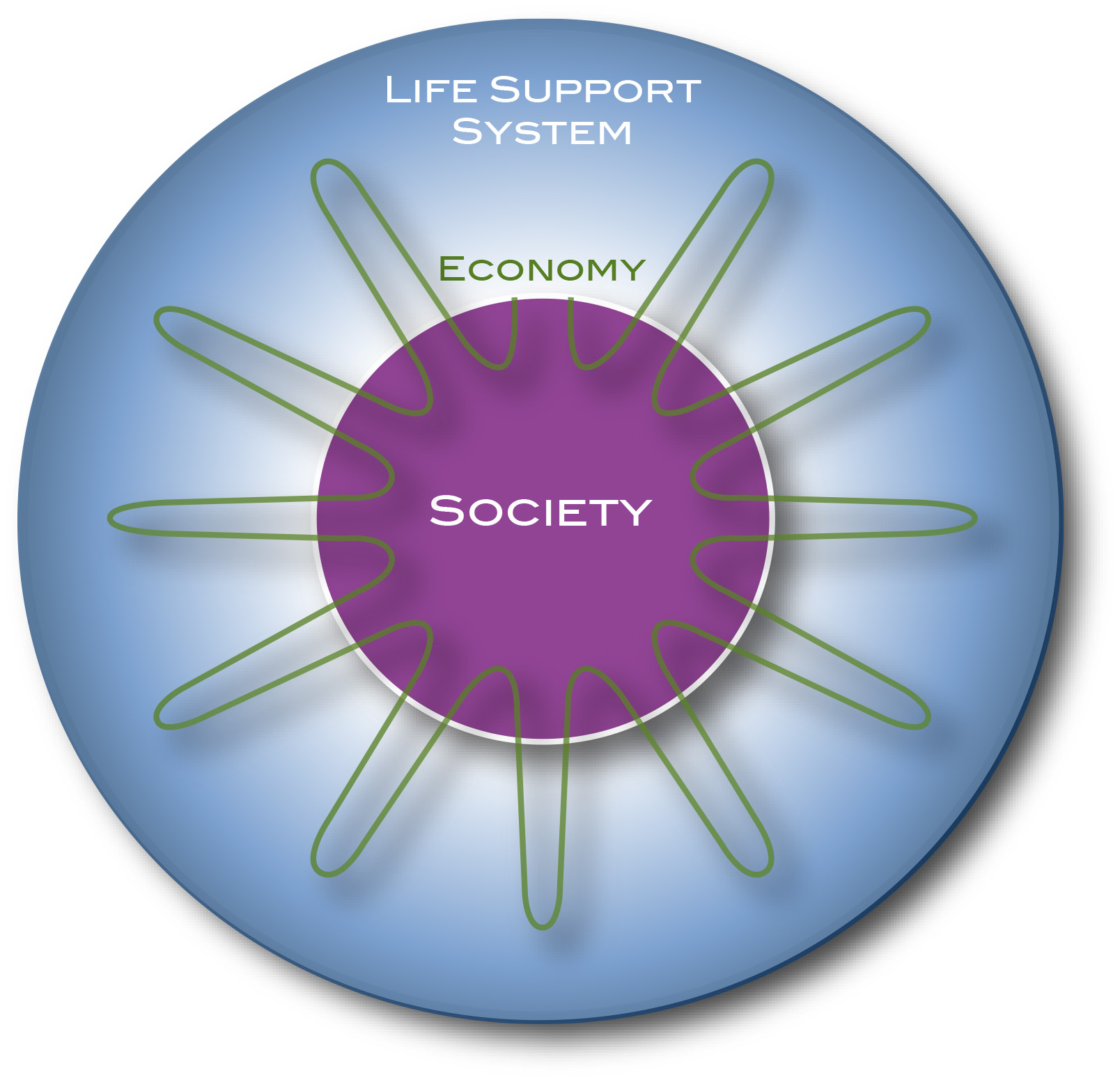Humanity and the Earth's Life-Support System
The notion of our planet being a life-support system for all life plays a central role in understanding humanity’s relationship to the planet. Humanity is embedded in, and dependent on, the Earth's life-support system (ELSS). Communities of human and non-human animals interact with the ELSS through flows of energy and matter (Figure 1); they take from the ELSS what they need to sustain the population, and they give back to the ELSS what remains after they have processed matter and changed the state of energy. All communities impact the ELSS in a complex way, and their interactions can improve or degrade the state of the ELSS with consequences for all other communities depending on the ELSS.
The flows between the ELSS and human communities are controlled to a very large extent by our ethical, social, and economic rules. For more than 250 years, almost all interactions of humans with the ELSS are economic in nature and controlled by an economic model that disregards the wealth of the non-human environment. Adam Smith (1776) defined the purpose of economy to be the creation of human wealth, with no regard of the impact this creation of wealth might have on the ELSS. As John M. Greer (2011) states, “it would be by no means inappropriate to define all of modern economic thoughts as footnotes to Smith.” Only recently have we started to realize that the disregard of “natural” or non-human wealth actually threatens not only our survival as a species but also endangers our economies (Heal, 2017; Korten, 2015).
Since Adam Smith made the creation of human wealth the sole purpose of economy, humanity has been extremely successful in modify the flows, seemingly to our advantage. On the way, we reduced many other species in great numbers, eliminated whole species at accelerating rates, and modified the basic functioning and physiology of the ELSS. We have obtained the position of being the operators of the ELSS. Being the only species that ever achieved this position in the ELSS, we have a new enormous responsibility. If we make mistakes, these mistakes will have enormous consequences.
To reach sustainability, safeguarding the ELSS has to be congenital to the economic rules. Although the vast majority of normative ethical accounts demand that the human population transitions to a fair, sustainable lifestyle, the economic rules that require perpetual growth are in tension with this moral requirement. In fact, the current rules are sustaining growth by accelerating the main mass and energy cycles in the ELSS leading to a cataclysmic degradation. Humanity has developed into the “anthropogenic cataclysmic virus” (ACV) in the ELSS. To reach sustainability, this virus is challenged with a transition into the healer.
Humanity has achieved a unique position in the ELSS and has the means to significantly change the state of the ELSS. Propelled by access to seemingly unlimited energy and technological progress, human population growth with associated resource consumption, habitat transformation and fragmentation, and climate change have degraded the ELSS. This has pushed the system out of an exceptionally stable state providing a “Safe Operating Space for Humanity” (SOSH) during the Holocene (Rockström et al., 2009) into a rapid transition to a new but yet unknown state. Humanity is “reengineering” the ELSS at global scale and changing its physiology fundamentally, including but not limited to the energy, water, Carbon, Nitrogen, and Phosphorous cycles, is mobilizing and adding new constituents into these cycles, and is rapidly reducing the number and diversity of non-human animals. A large fraction of the Earth surface has been changed to meet our needs, and as a result the extinction rate is accelerating and at an unsustainable high (Barnosky et al., 2012). In an analog to medicine, we find that humanity has developed into the “anthropogenic cataclysmic virus” (ACV) in the ELSS (Plag, 2015). To reach sustainability, this virus is challenged with a transition into the healer. This transition requires overcoming the current inconsistency between normative ethics and the prevailing economic, social and governance practices.
|


Figure 1: Humanity and the Earth's life-support system.
Most interactions between human communities and the ELSS are economic (top). Human communities interact with the ELSS through flows of energy and matter (bottom), and these flows are under the influence of economic rules, which in turn are impacted by social and ethical norms.
For a species as powerful and impactful as humans have become, safeguarding the ELSS has to be a core concern if survival of our species and many other species matters. Since Adam Smith 240 years ago lay out the basis for economies as we know them, almost all interactions of humanity with the ELSS are governed by economic rules. Consequently, the extent to which communities safeguard the ELSS depends crucially on the economic model. Safeguarding the ELSS has to be congenital to the economic rules. Safeguarding the ELSS requires an economy that understands the ELSS and aims at a healthy ELSS in the same way health sciences and practitioners understand human health and aim at safeguarding our individual life-support systems.
Although the vast majority of normative ethical accounts demand that the human population transitions to a fair, sustainable lifestyle, the economic rules that require perpetual growth are in tension with this moral requirement. In fact, the current rules are sustaining growth by accelerating the main mass and energy cycles in the ELSS. However, being successful for some time does not equate to being sustainable. The acceleration of the flows is leading to a cataclysmic degradation. Making progress towards an economy that satisfies our needs while safeguarding the ELSS requires a fundamental transformation of the paradigms our economies are based on. In an “economy for humanity” (E4H), the overarching goal is to ensure thriving communities by satisfying the needs of the present while safeguarding the ELSS.
|